Enhancing the Mechanical Properties of AM60B Magnesium Alloys through Graphene Addition: Characterization and Regression Analysis
Abstract
:1. Introduction
2. Materials and Methods
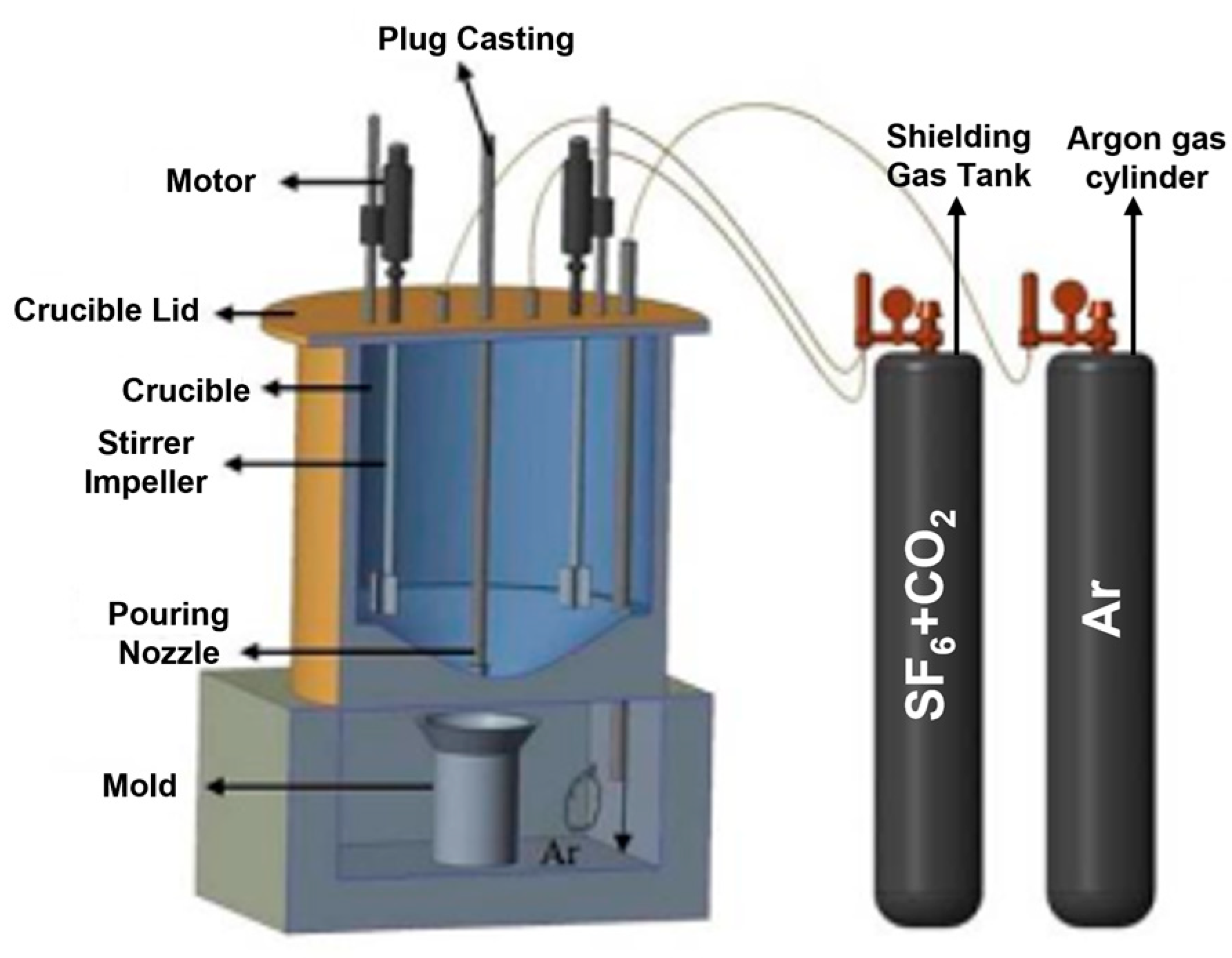
3. Results
3.1. Microstructural Characterization
3.1.1. X-ray Diffraction
3.1.2. Raman Spectroscopy
3.1.3. Optical Microscopy
3.1.4. SEM-EDS Analysis
3.2. Mechanical Testing
3.2.1. Tensile Testing
| Material | Yield Strength (MPa) | Ultimate Tensile Strength (MPa) | References |
|---|---|---|---|
| AZ31 | 183 ± 4.3 | 267 ± 6.5 | [32] |
| AZ31-1.5GNP | 187 ± 3.5 | 284 ± 5.4 | |
| AZ31-3GNP | 195 ± 4.5 | 299 ± 6.2 | |
| ZK61 | 187 ± 1 | 307 ± 1 | [33] |
| ZK61-0.1RGO | 191 ± 2 | 307 ± 0 | |
| ZK61-0.25RGO | 195 ± 1 | 298 ± 1 | |
| ZK61-0.4RGO | 200 ± 2 | 301 ± 0 | |
| ZK61-0.6RGO | 203 ± 2 | 312 ± 3 | |
| AZ61 alloy | 184 ± 5.5 | 300 ± 7.1 | [34] |
| AZ61-3GNP | 232 ± 5.5 | 335 ± 9.1 | |
| AZ80 | 104 ± 5.2 | 271 ± 13.5 | [35] |
| AZ80-0.1GNP | 146 ± 7.3 | 310 ± 15.5 | |
| AZ80-0.2GNP | 160 ± 16 | 325 ± 32 | |
| AZ91(T4) | 168 ± 5.0 | 215 ± 6.0 | [36] |
| AZ91-0.1GNS | 223 ± 3.6 | 276 ± 4.2 | |
| AZ91-0.3GNS | 268 ± 4.6 | 318 ± 5.0 | |
| AZ91-0.5GNS | 296 ± 3.7 | 335 ± 4.8 | |
| AZ91-0.8GNS | 252 ± 5.5 | 307 ± 5.0 | |
| AZ91-1.2GNS | 234 ± 3.0 | 287 ± 5.0 | |
| AM60B | 101.7 ± 4.9 | 229.4 ± 4.0 | This Study |
| AM60B-0.1 wt.% graphene | 115.3 ± 5.6 | 256.7 ± 3.7 | |
| AM60B-0.2 wt.% graphene | 93.2 ± 4.1 | 215.4 ± 5.5 |
3.2.2. Microhardness Testing
3.3. Regression Analysis Based on Mechanical Testing
4. Discussion
4.1. Strengthening Mechanism
4.2. Fracture Surface Study
4.3. Regression Analysis Using Machine Learning Metrics
5. Conclusions
- Incorporating 0.1 wt.% graphene into the AM60B magnesium alloy resulted in a significant improvement in yield strength, achieving a 12% increase compared to the alloy without graphene. These results indicate that a modest addition of graphene effectively enhances the alloy’s mechanical performance.
- The addition of 0.1 wt.% graphene not only enhanced the yield strength by approximately 13.4% but also increased the strain at break by 8.8%. This suggests that a small amount of graphene slightly improves both the strength and ductility of the alloy, making it more robust and versatile for various applications.
- However, increasing the graphene content to 0.2 wt.% reduced the tensile strength. This decline was likely due to the agglomeration of graphene particles and the resulting increase in brittleness, which compromised the alloy’s overall mechanical properties.
- Regression analysis of the tensile curves showed that the addition of 0.1 and 0.2 wt.% graphene slightly reduced the model accuracy, as reflected by the mean squared error (MSE) of approximately 0.065. However, the accuracy remained high, indicating the model’s robustness despite the challenges posed by the reinforcement.
- The thermal stability of AM60B/graphene composites, particularly in relation to the formation of the MgC2 phase, was not assessed in this study. Given that graphene is well-regarded for its excellent thermal stability, investigating this aspect could provide valuable insights into how it influences the thermal behavior of the composites.
- In future work, the exploration of more complex regions of the stress–strain curve, such as the plastic region, may benefit from hyperparameter tuning to improve model performance.
Author Contributions
Funding
Institutional Review Board Statement
Informed Consent Statement
Data Availability Statement
Acknowledgments
Conflicts of Interest
References
- Ni, F.; Peng, J.; Liu, X.; Gao, P.; Nie, Z.; Hu, J.; Zhao, D. Modification of Microstructure and Mechanical Properties of Extruded AZ91-0.4Ce Magnesium Alloy through Addition of Ca. Materials 2024, 17, 3359. [Google Scholar] [CrossRef]
- Alaneme, K.K.; Okotete, E.A. Enhancing plastic deformability of Mg and its alloys—A review of traditional and nascent developments. J. Magnes. Alloys 2017, 5, 460–475. [Google Scholar] [CrossRef]
- Huang, S.-J.; Li, C.; Sarkar, M.; Li, W.; Kannaiyan, S.; Bilgili, H.K.; Al-Mallahi, D.A.F.; Todoh, M. Mechanical Study Reinforced Magnesium-Yttrium Alloys by Eggshell Powder Using Resistance Casting. J. Alloys Compd. 2024, 1008, 176458. [Google Scholar] [CrossRef]
- Yang, Q.; Jiang, B.; Gao, L.; Gao, Y.; Liang, B.; Lan, S.; Qin, Z.; Zou, W.; Yang, F.; Pan, F. Study on Plastic Constitutive Relation and Ductile Fracture Criterion of AM60B Magnesium Alloy. Materials 2024, 17, 1684. [Google Scholar] [CrossRef]
- Khan, M.; Tahir, M.N.; Adil, S.F.; Khan, H.U.; Siddiqui, M.R.H.; Al-Warthan, A.A.; Tremel, W. Graphene Based Metal and Metal Oxide Nanocomposites: Synthesis, Properties and their Applications. J. Mater. Chem. A 2015, 3, 18753–18808. [Google Scholar] [CrossRef]
- Vlassiouk, I.; Polizos, G.; Cooper, R.; Ivanov, I.; Keum, J.K.; Paulauskas, F.; Datskos, P.; Smirnov, S. Strong and Electrically Conductive Graphene-Based Composite Fibers and Laminates. ACS Appl. Mater. Interfaces 2015, 7, 10702–10709. [Google Scholar] [CrossRef]
- Fan, Y.; Ye, L.; Tian, Q.; Zhuang, Y.; Zhang, Y.; Li, X. Effects of aligned graphene sheets on mechanical properties of ZK61 alloy. Mater. Sci. Eng. A 2021, 801, 140417. [Google Scholar] [CrossRef]
- Shahil, K.M.F.; Balandin, A.A. Graphene-multilayer graphene nanocomposites as highly efficient thermal interface materials. Nano Lett. 2012, 12, 861–867. [Google Scholar] [CrossRef]
- Huang, S.-J.; Adityawardhana, Y.; Kannaiyan, S. Enhancement strength of AZ91 magnesium alloy composites reinforced with graphene by T6 heat treatment and equal channel angular pressing. Arch. Civ. Mech. Eng. 2024, 24, 235. [Google Scholar] [CrossRef]
- Prashantha Kumar, H.G.; Anthony Xavior, M. Graphene Reinforced Metal Matrix Composite (GRMMC): A Review. Procedia Eng. 2014, 97, 1033–1040. [Google Scholar] [CrossRef]
- Chen, Z.; Taplin, D.J.; Weyland, M.; Allen, L.J.; Findlay, S.D. Composition measurement in substitutionally disordered materials by atomic resolution energy dispersive X-ray spectroscopy in scanning transmission electron microscopy. Ultramicroscopy 2017, 176, 52–62. [Google Scholar] [CrossRef] [PubMed]
- Stangl, J.; Mocuta, C.; Diaz, A.; Metzger, T.H.; Bauer, G. X-Ray Diffraction as a Local Probe Tool; Wiley-VCH Verlag: Hoboken, NJ, USA, 2009. [Google Scholar] [CrossRef]
- Zhao, W.; Liu, J.K.; Chen, Y.Y. Material behavior modeling with multi-output support vector regression. Appl. Math. Model 2015, 39, 5216–5229. [Google Scholar] [CrossRef]
- Huang, S.J.; Selvaraju, S.; Subramani, M.; Li, C. The synergistic impact of graphene and copper on microstructure, corrosion behaviors and biocompatibility of a magnesium metal matrix composite in Hank’s solution. J. Taiwan Inst. Chem. Eng. 2024, 162, 105596. [Google Scholar] [CrossRef]
- Huang, S.J.; Wang, C.F.; Subramani, M.; Selvaraju, S.; Rajagopal, V.; Chiang, C.C.; Fan, F.F. The Impact of Graphene on the Mechanical Properties, Corrosion Behavior, and Biocompatibility of an Mg–Ca Alloy. J. Am. Ceram. Soc. 2024. [Google Scholar] [CrossRef]
- Cashion, S.P.; Ricketts, N.J.; Hayes, P.C. Characterisation of protective surface films formed on molten magnesium protected by air/SF 6 atmospheres. J. Light Met. 2002, 2, 37–42. [Google Scholar] [CrossRef]
- Huang, S.J.; Subramani, M.; Ali, A.N.; Alemayehu, D.B.; Aoh, J.N.; Lin, P.C. The Effect of Micro-SiCp Content on the Tensile and Fatigue Behavior of AZ61 Magnesium Alloy Matrix Composites. Int. J. Met. 2021, 15, 780–793. [Google Scholar] [CrossRef]
- Morsiya, C.H.; Pandya, S. Effect of stir casting process parameters and stirrer blade geometry on mechanical properties of al MMCs—A review. Arch. Metall. Mater. 2023, 68, 1473–1495. [Google Scholar] [CrossRef]
- Huanga, S.J.; Kannaiyan, S.; Subramani, M. Effect of nano-Nb2O5 on the microstructure and mechanical properties of AZ31 alloy matrix nanocomposites. Adv. Nano Res. 2022, 13, 407–416. [Google Scholar] [CrossRef]
- Subramani, M.; Huang, S.J.; Borodianskiy, K. Effect of SiC Nanoparticles on AZ31 Magnesium Alloy. Materials 2022, 15, 1004. [Google Scholar] [CrossRef]
- Rashad, M.; Pan, F.; Asif, M.; Chen, X. Corrosion behavior of magnesium-graphene composites in sodium chloride solutions. J. Magnes. Alloys 2017, 5, 271–276. [Google Scholar] [CrossRef]
- Kiełbus, A.; Jarosz, R.; Gryc, A. Effect of modification on microstructure and properties of AZ91 magnesium alloy. Crystals 2020, 10, 536. [Google Scholar] [CrossRef]
- Kim, S.; Kim, K.; Koo, J.; Lee, H.; Min, B.I.; Kim, D.Y. Pressure-induced phase transitions and superconductivity in magnesium carbides. Sci. Rep. 2019, 9, 20253. [Google Scholar] [CrossRef] [PubMed]
- Cordero, Z.C.; Knight, B.E.; Schuh, C.A. Six Decades of the Hall–Petch Effect—A Survey of Grain-Size Strengthening Studies on Pure Metals; Taylor and Francis Ltd.: Abingdon, UK, 2016. [Google Scholar] [CrossRef]
- Wang, B.B.; Xie, G.M.; Wu, L.H.; Xue, P.; Ni, D.R.; Xiao, B.L.; Liu, Y.D.; Ma, Z.Y. Grain size effect on tensile deformation behaviors of pure aluminum. Mater. Sci. Eng. A 2021, 820, 141504. [Google Scholar] [CrossRef]
- Rickman, J.M.; Lawrence, A.; Rollett, A.D.; Harmer, M.P. Calculating probability densities associated with grain-size distributions. Comput. Mater. Sci. 2015, 101, 211–215. [Google Scholar] [CrossRef]
- Furukawa, M.; Horita, Z.; Nemoto, M.; Valiev, R.Z.; Langdon, T.G. Microhardness measurements and the Hall-Petch relationship in an Al-Mg alloy with submicrometer grain size. Acta Mater. 1996, 44, 4619–4629. [Google Scholar] [CrossRef]
- Huang, S.J.; Li, C.; Feng, J.H.; Selvaraju, S.; Subramani, M. Mechanical and Corrosion Tests for Magnesium–Zinc/Ti-6Al-4V Composites by Gravity Casting. Materials 2024, 17, 1836. [Google Scholar] [CrossRef]
- Naseer, A.; Ahmad, F.; Muhsan, A.S.; Aslam, M. ScienceDirect Investigation of suitable graphene reinforcements for copper based PIM feedstock. Mater. Today Proc. 2019, 16, 2052–2059. [Google Scholar] [CrossRef]
- Du, X.; Du, W.; Wang, Z.; Liu, K.; Li, S. Defects in graphene nanoplatelets and their interface behavior to reinforce magnesium alloys. Appl. Surf. Sci. 2019, 484, 414–423. [Google Scholar] [CrossRef]
- Tiwari, J.K.; Mandal, A.; Rudra, A.; Sathish, N.; Kumar, S.; Singh, A.K. Influence of graphene content on the mechanical properties of severely deformed graphene/aluminum composite. Mater. Chem. Phys. 2020, 248, 122939. [Google Scholar] [CrossRef]
- Rashad, M.; Pan, F.; Liu, Y.; Chen, X.; Lin, H.; Pan, R.; Asif, M.; She, J. High temperature formability of graphene nanoplatelets-AZ31 composites fabricated by stir-casting method. J. Magnes. Alloys 2016, 4, 270–277. [Google Scholar] [CrossRef]
- Liu, F.; Wang, Z.; Du, X.; Li, S.; Du, W. Microstructure and Mechanical Properties of Magnesium Matrix Composites Reinforced by In Situ Reduced Graphene Oxide. Materials 2023, 16, 2303. [Google Scholar] [CrossRef] [PubMed]
- Rashad, M.; Pan, F.; Lin, D.; Asif, M. High temperature mechanical behavior of AZ61 magnesium alloy reinforced with graphene nanoplatelets. Mater. Des. 2016, 89, 1242–1250. [Google Scholar] [CrossRef]
- Parizi, M.T.; Ebrahimi, G.R.; Ezatpour, H.R. Effect of graphene nanoplatelets content on the microstructural and mechanical properties of AZ80 magnesium alloy. Mater. Sci. Eng. A 2019, 742, 373–389. [Google Scholar] [CrossRef]
- Yuan, Q.H.; Zhou, G.H.; Liao, L.; Liu, Y.; Luo, L. Interfacial structure in AZ91 alloy composites reinforced by graphene nanosheets. Carbon 2018, 127, 177–186. [Google Scholar] [CrossRef]
- Venkatesan, S.; Anthony Xavior, M. Tensile behavior of aluminum alloy (AA7050) metal matrix composite reinforced with graphene fabricated by stir and squeeze cast processes. Sci. Technol. Mater. 2018, 30, 74–85. [Google Scholar] [CrossRef]
- Huang, S.J.; Mose, M.P.; Kannaiyan, S. A study of the mechanical properties of AZ61 magnesium composite after equal channel angular processing in conjunction with machine learning. Mater. Today Commun. 2022, 33, 104707. [Google Scholar] [CrossRef]
- Huang, S.J.; Adityawardhana, Y.; Sanjaya, J. Predicting Mechanical Properties of Magnesium Matrix Composites with Regression Models by Machine Learning. J. Compos. Sci. 2023, 7, 347. [Google Scholar] [CrossRef]
- Xu, Y.; Goodacre, R. On Splitting Training and Validation Set: A Comparative Study of Cross-Validation, Bootstrap and Systematic Sampling for Estimating the Generalization Performance of Supervised Learning. J. Anal. Test. 2018, 2, 249–262. [Google Scholar] [CrossRef]
- Snee, R.D. Validation of Regression Models: Methods and Examples. Technometrics 1977, 19, 415–428. [Google Scholar] [CrossRef]
- Sipper, M. High Per Parameter: A Large-Scale Study of Hyperparameter Tuning for Machine Learning Algorithms. arXiv 2022, arXiv:2207.06028. [Google Scholar]
- Fan, H.; Wang, Q.; El-Awady, J.A.; Raabe, D.; Zaiser, M. Strain rate dependency of dislocation plasticity. Nat. Commun. 2021, 12, 1845. [Google Scholar] [CrossRef]
- Kostryzhev, A.G. Strengthening mechanisms in metallic materials. Metals 2021, 11, 1134. [Google Scholar] [CrossRef]
- Li, C.L.; Mei, Q.S.; Li, J.Y.; Chen, F.; Ma, Y.; Mei, X.M. Hall-Petch relations and strengthening of Al-ZnO composites in view of grain size relative to interparticle spacing. Scr. Mater. 2018, 153, 27–30. [Google Scholar] [CrossRef]
- Singh, H.; Kumar, D. Validation of Novel Geometrically Necessary Dislocations Calculation Model Using Nanoindentation of the Metal Matrix Nanocomposite. Metall. Mater. Trans. A Phys. Metall. Mater. Sci. 2020, 51, 6700–6705. [Google Scholar] [CrossRef]
- Huang, S.J.; Abbas, A.; Ballóková, B. Effect of CNT on microstructure, dry sliding wear and compressive mechanical properties of AZ61 magnesium alloy. J. Mater. Res. Technol. 2019, 8, 4273–4286. [Google Scholar] [CrossRef]
- Hadadzadeh, A.; Amirkhiz, B.S.; Mohammadi, M. Contribution of Mg2Si precipitates to the strength of direct metal laser sintered AlSi10Mg. Mater. Sci. Eng. A 2019, 739, 295–300. [Google Scholar] [CrossRef]
- Zong, B.Y.; Zhang, F.; Wang, G.; Zuo, L. Strengthening mechanism of load sharing of particulate reinforcements in a metal matrix composite. J. Mater. Sci. 2007, 42, 4215–4226. [Google Scholar] [CrossRef]
- Várdai, R.; Lummerstorfer, T.; Pretschuh, C.; Jerabek, M.; Gahleitner, M.; Faludi, G.; Móczó, J.; Pukánszky, B. Comparative study of fiber reinforced PP composites: Effect of fiber type, coupling and failure mechanisms. Compos. Part A Appl. Sci. Manuf. 2020, 133, 105895. [Google Scholar] [CrossRef]
- Yoo, M.H.; Song, J.; Oh, J.; Kang, S.; Kim, K.; Yang, S.; Moon, M. Development of a bus armrest fabrication process with a high-vacuum, high-pressure die-casting process using the AM60 alloy. Robot. Comput. Integr. Manuf. 2019, 55, 154–159. [Google Scholar] [CrossRef]
- Jan, R.; Habib, A.; Abbasi, H.Y. High aspect ratio graphene nanosheets cause a very low percolation threshold for polymer nanocomposites. Acta Phys. Pol. A 2016, 129, 478–481. [Google Scholar] [CrossRef]
- Tang, Y.; Xie, C.; Chen, J.; Wang, X. Atomistic Insights into the Competition between Damage and Dynamic Recrystallization Stimulated by the Precipitate Mgi7Ali2 in Magnesium Alloys. Metals 2022, 12, 633. [Google Scholar] [CrossRef]
- Arsenault, R.J.; Shi, N. Dislocation Generation Due to Differences between the Coefficients of Thermal Expansion. Mater. Sci. Eng. 1986, 81, 175–187. [Google Scholar] [CrossRef]
- Lukáč, P.; Rudajevová, A. Thermal expansion in magnesium composites. Kov. Mater.-Met. Mater. 2003, 41, 281–292. [Google Scholar]
- Yoon, D.; Son, Y.W.; Cheong, H. Negative thermal expansion coefficient of graphene measured by raman spectroscopy. Nano Lett. 2011, 11, 3227–3231. [Google Scholar] [CrossRef] [PubMed]
- Alexopoulos, N.D.; Paragkamian, Z.; Poulin, P.; Kourkoulis, S.K. Fracture related mechanical properties of low and high graphene reinforcement of epoxy nanocomposites. Compos. Sci. Technol. 2017, 150, 194–204. [Google Scholar] [CrossRef]


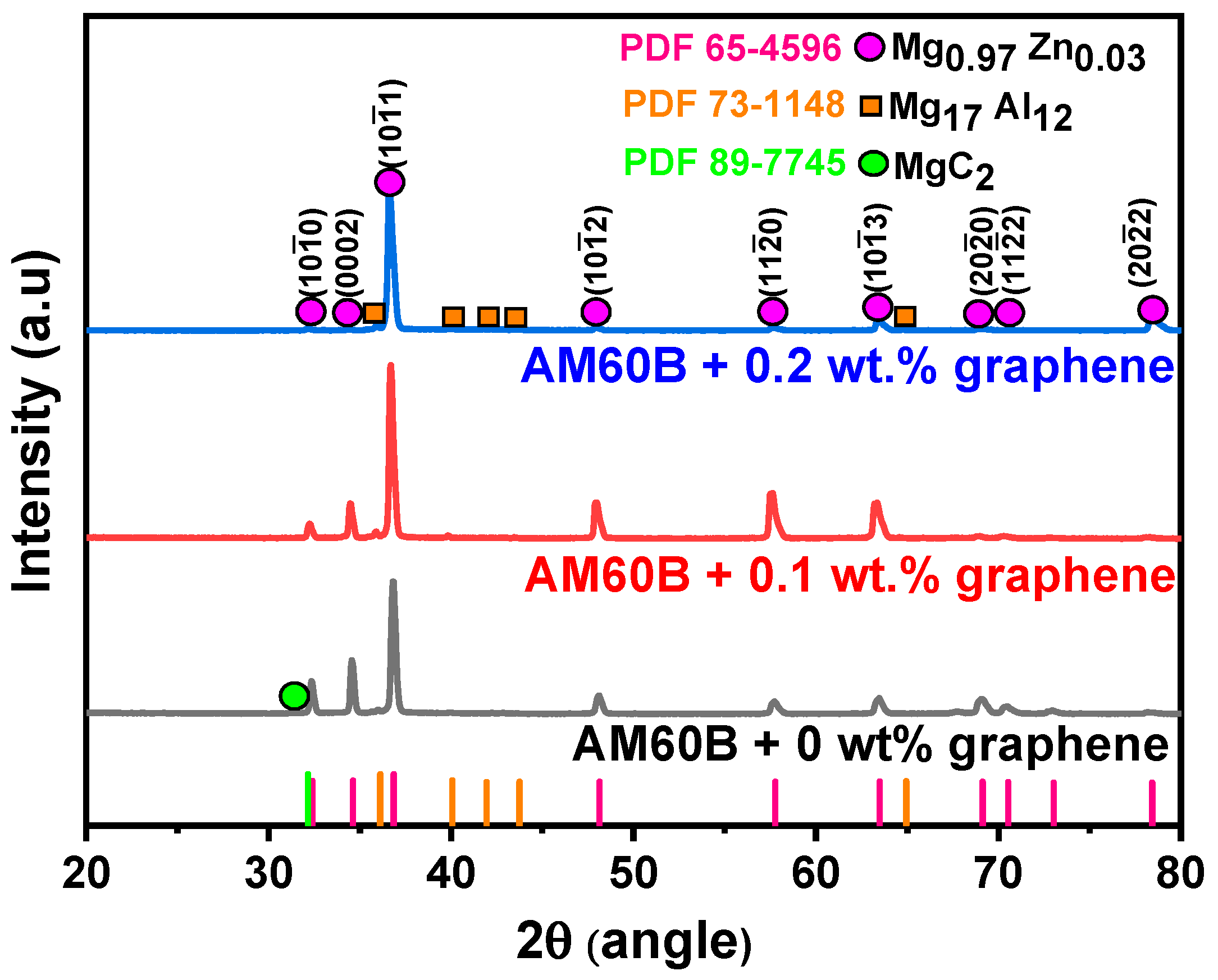
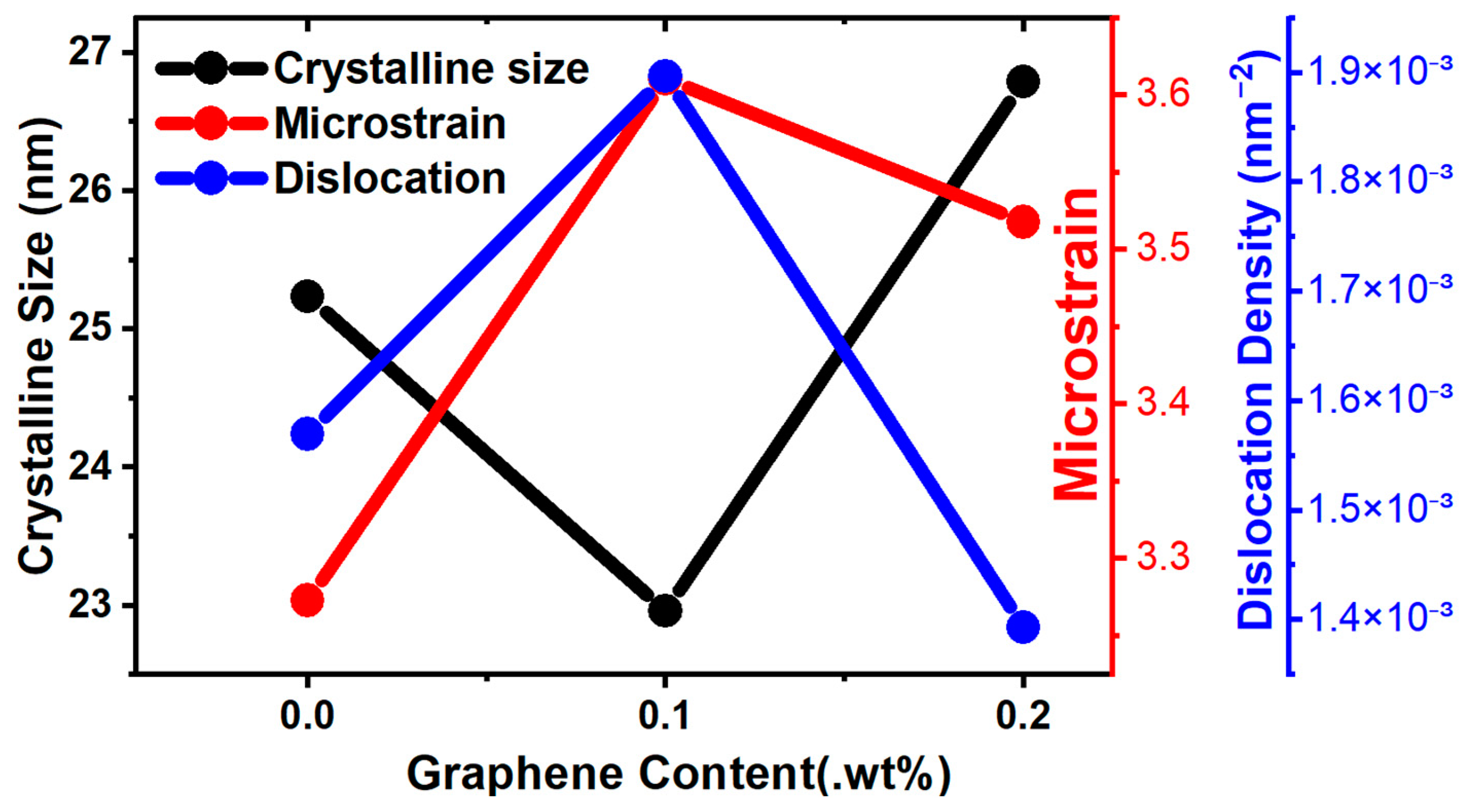
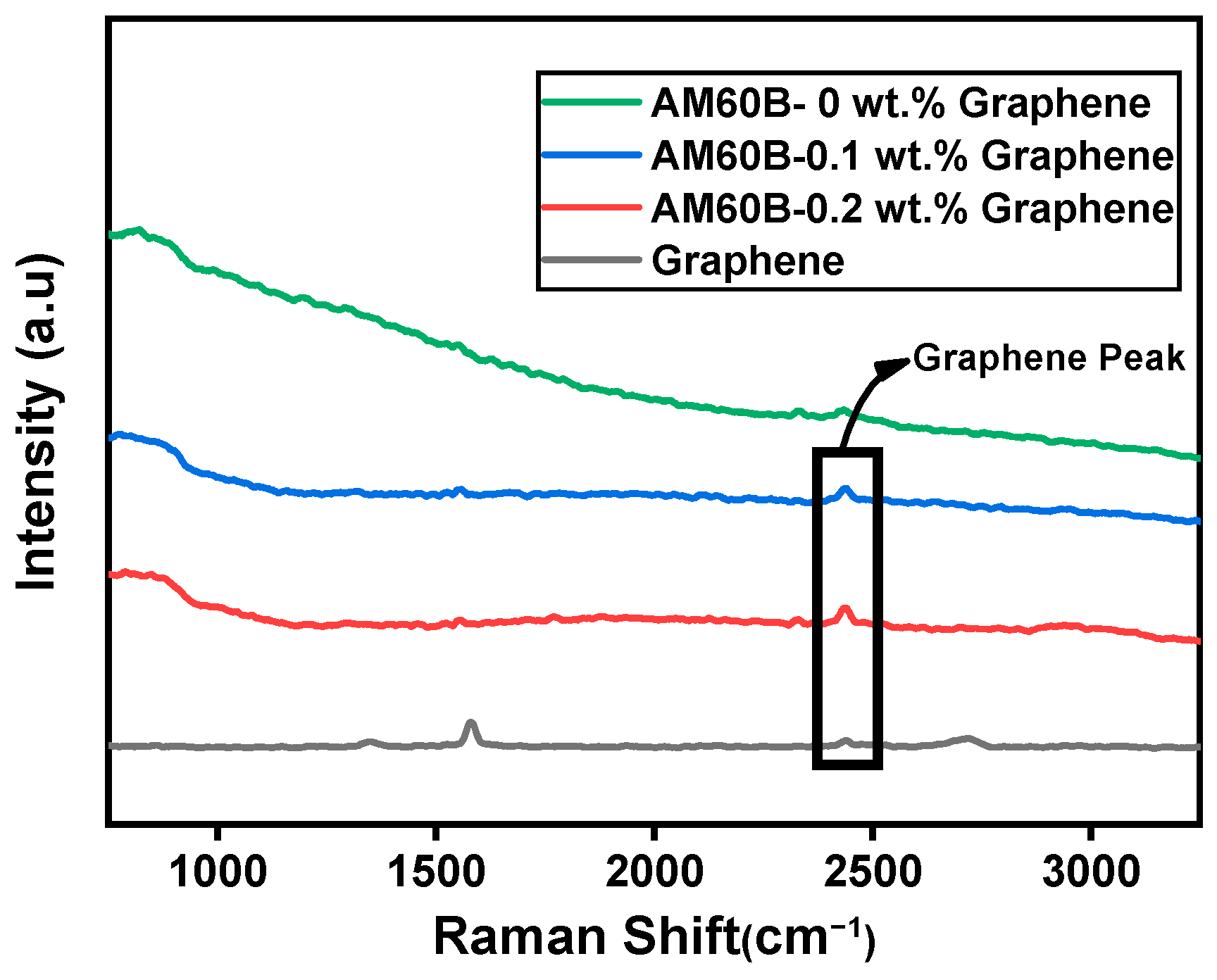

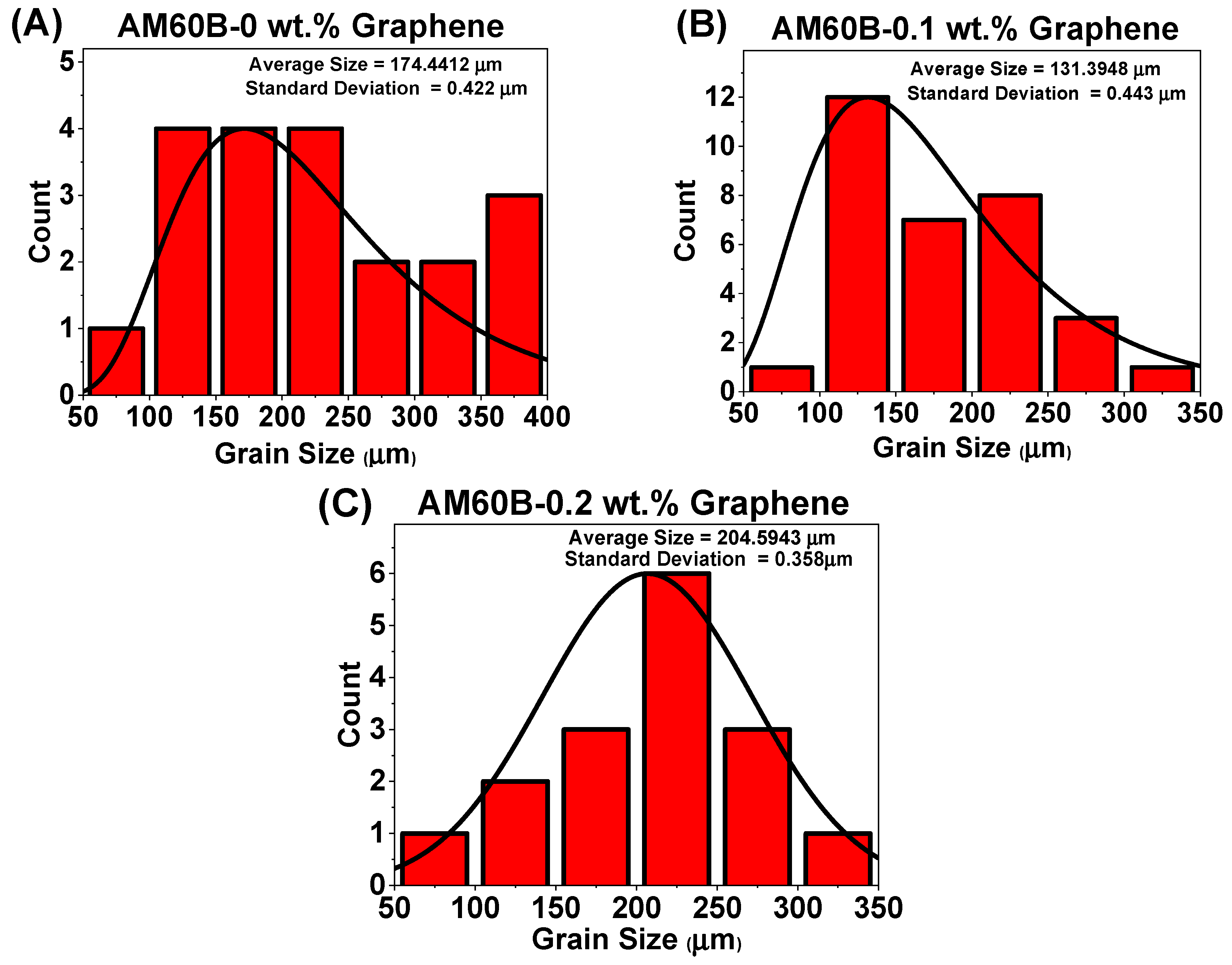
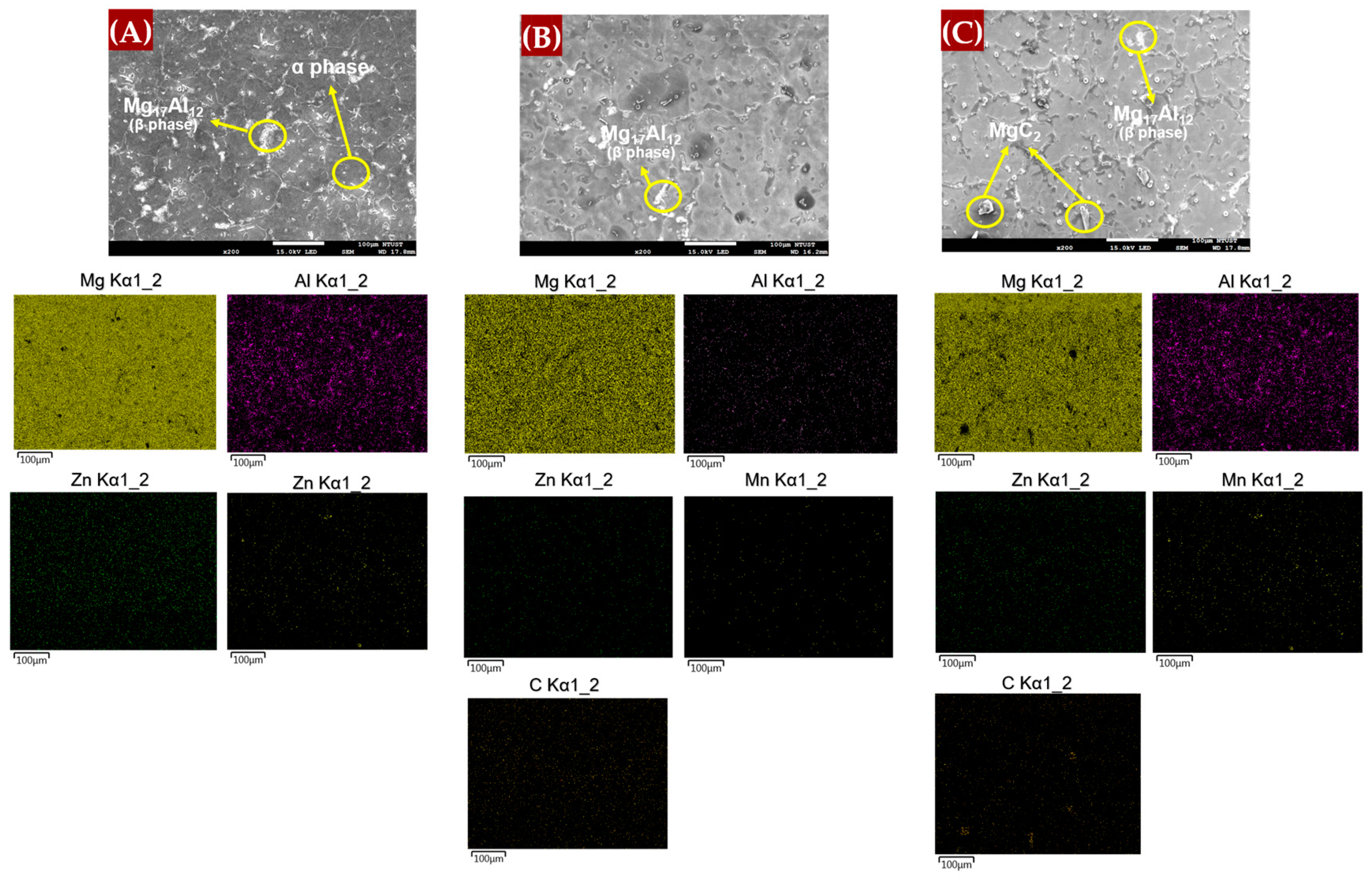


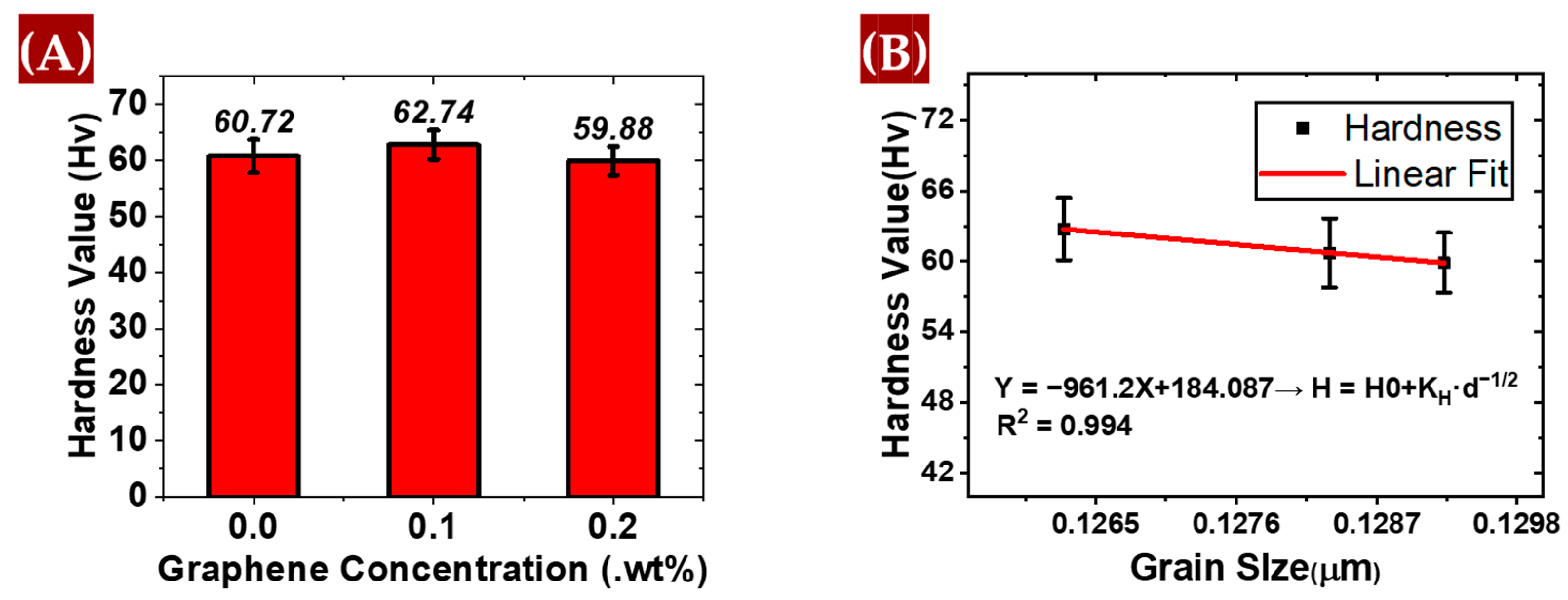
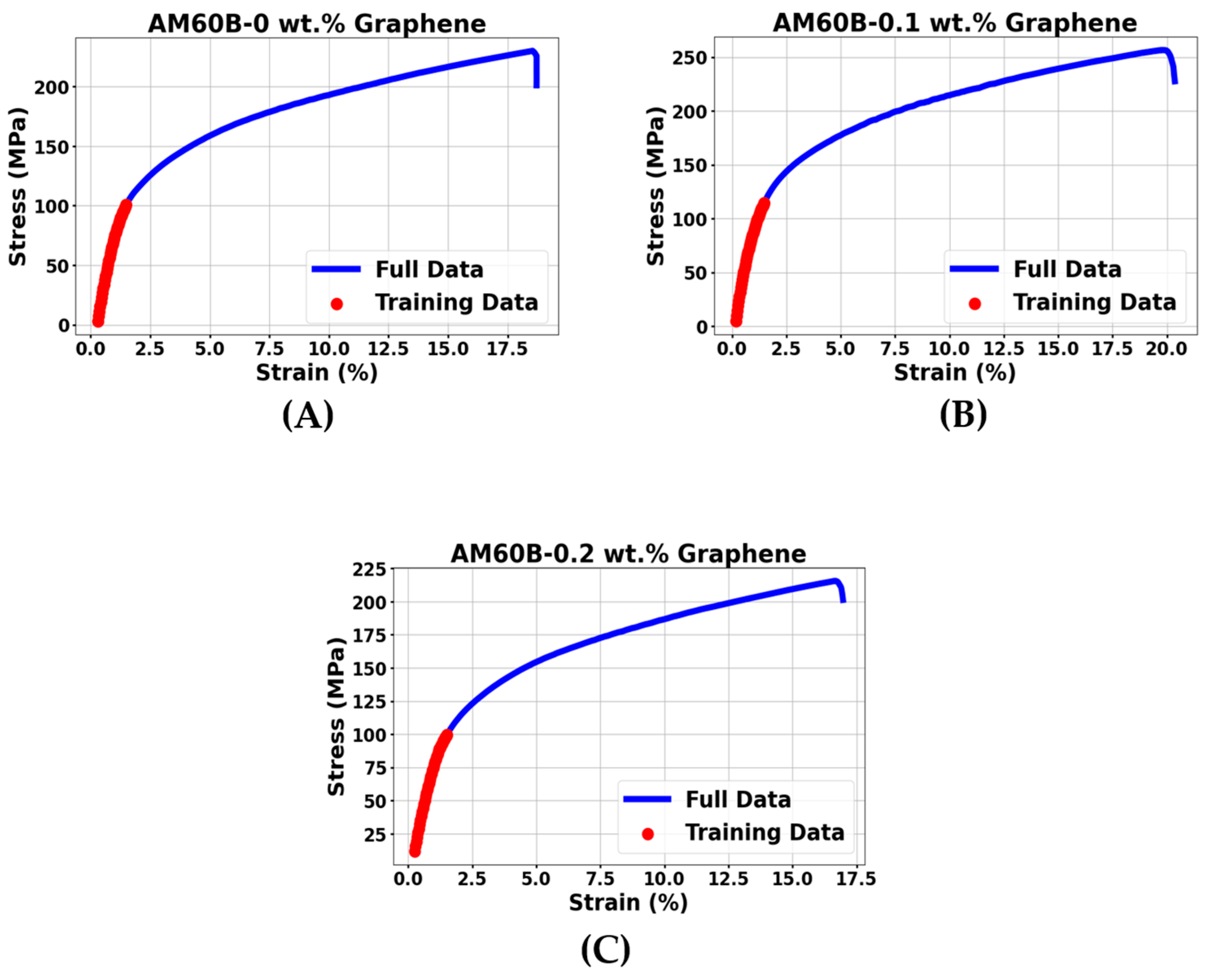

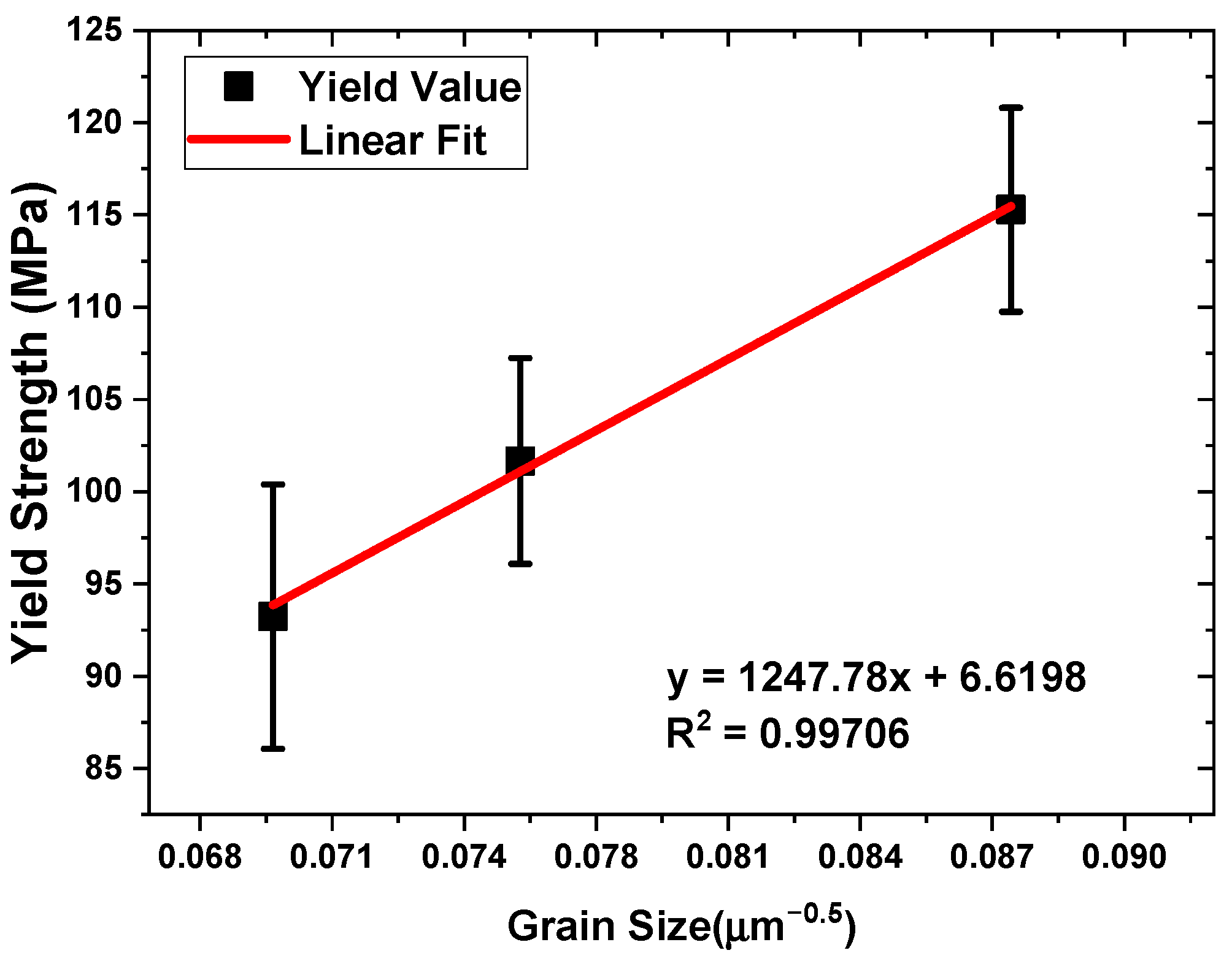
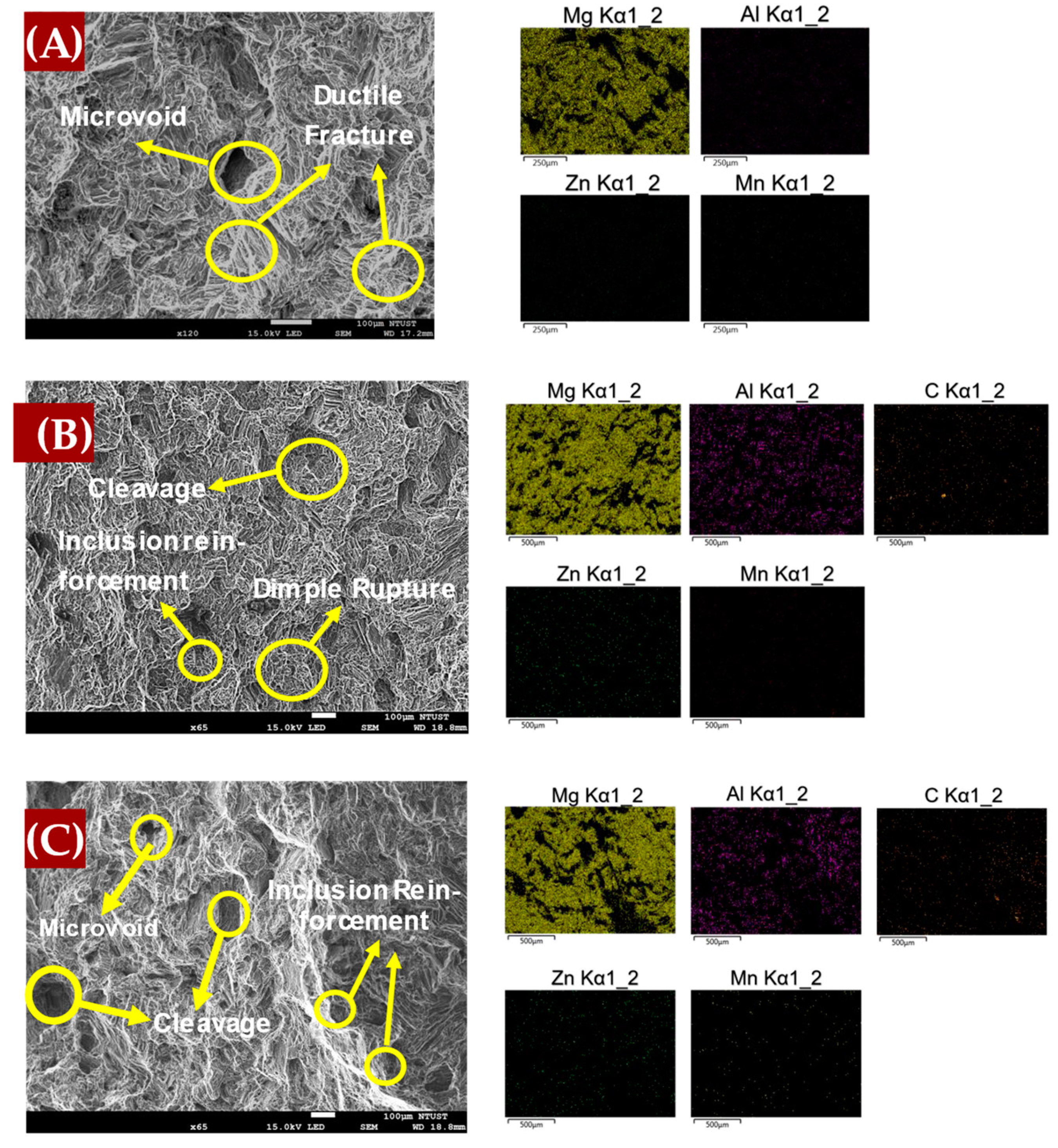
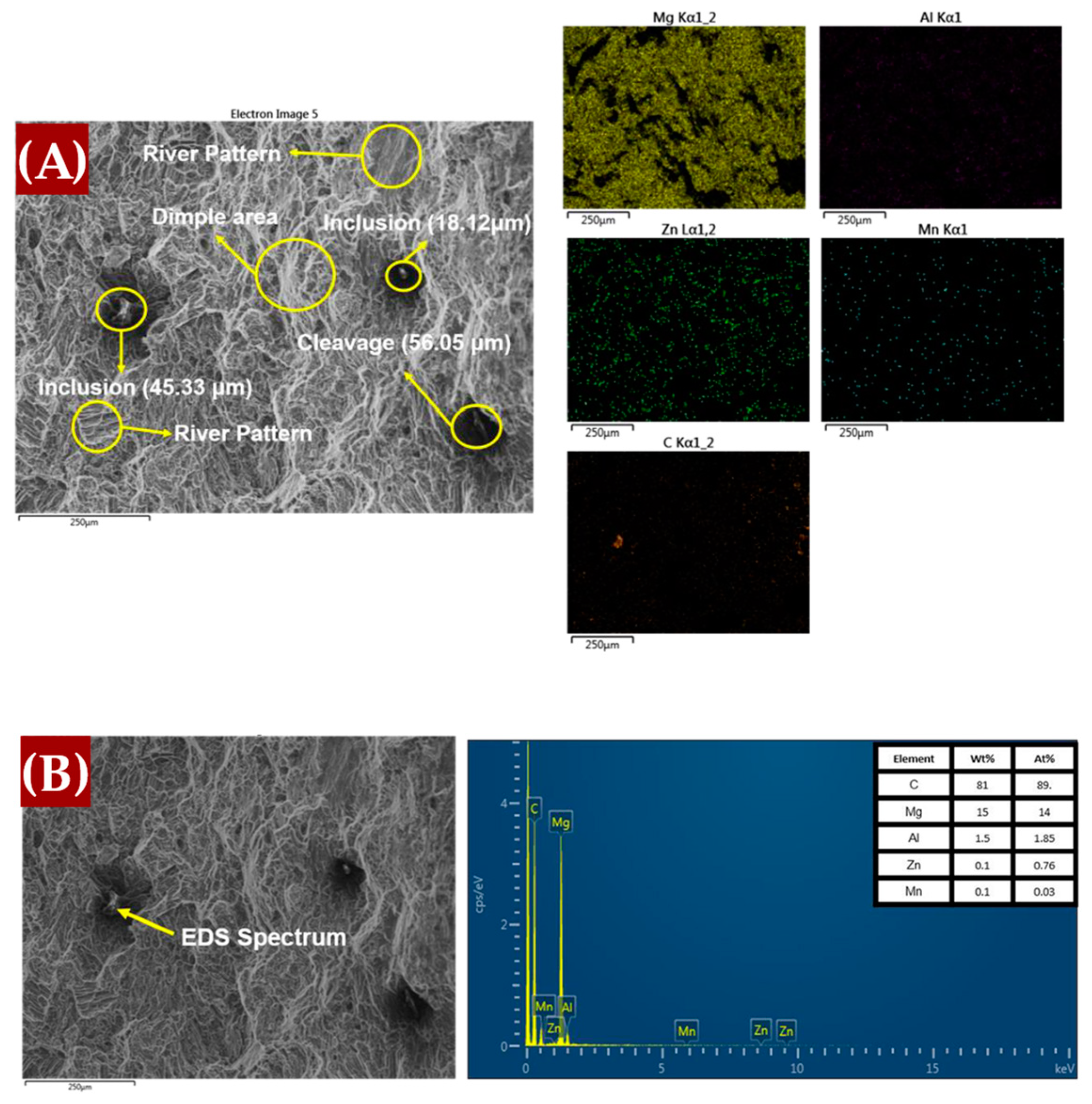
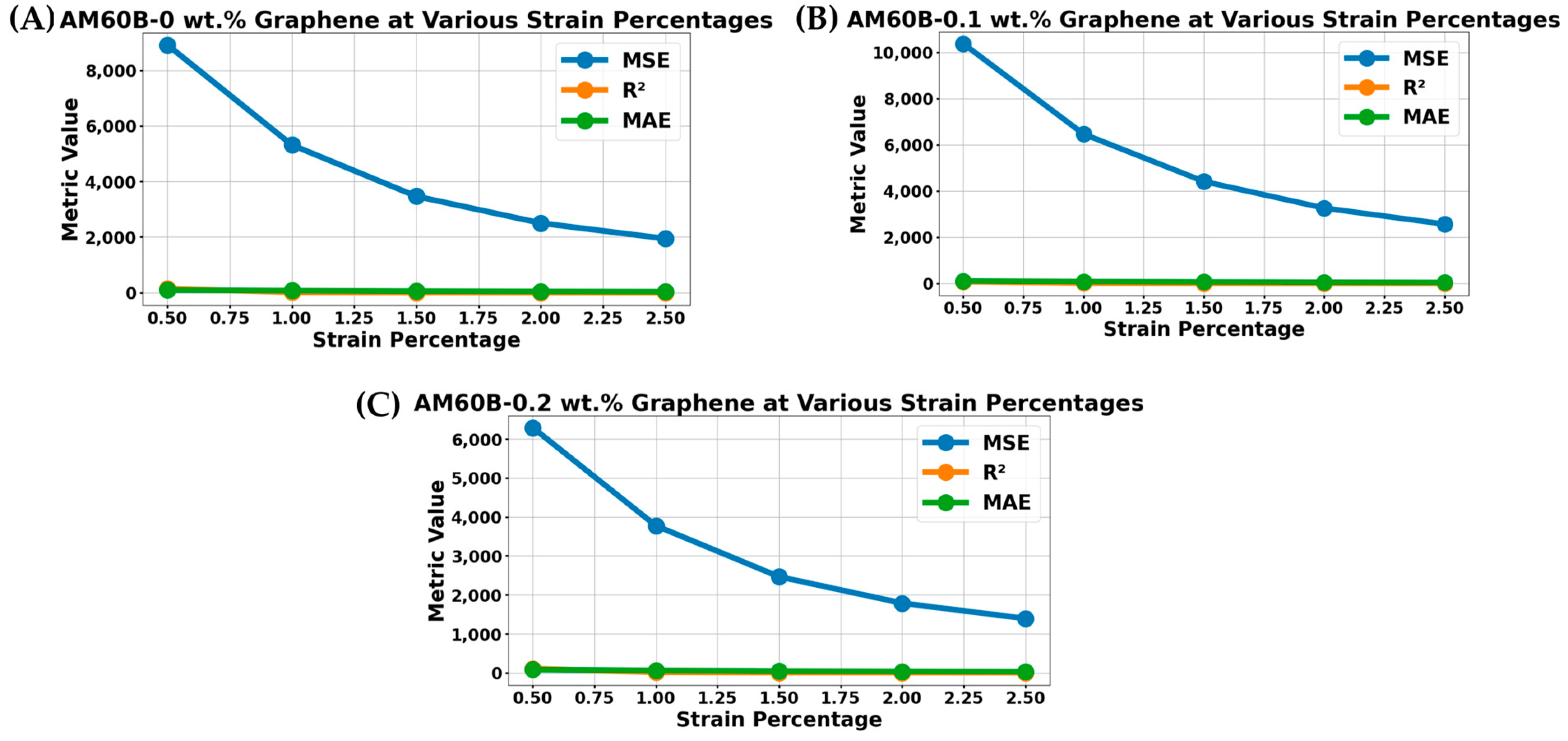
| Elements | Al | Mn | Zn | Si | Fe | Cu | Ni | Mg |
|---|---|---|---|---|---|---|---|---|
| wt.% | 5.800 | 0.320 | 0.220 | 0.100 | 0.005 | 0.01 | 0.002 | Bal |
| No. | Matrix (AM60B) (wt.%) | Reinforcement (Graphene) (wt.%) |
|---|---|---|
| 1 | 100 | 0 |
| 2 | 99.9 | 0.1 |
| 3 | 99.8 | 0.2 |
| Associated Phases | Peak Positions |
|---|---|
| Mg0.97Zn0.03 | 32.391 |
| 34.611 | |
| 36.854 | |
| 48.131 | |
| 57.776 | |
| 63.499 | |
| 67.812 | |
| 69.13 | |
| 70.525 | |
| 73.017 | |
| 78.424 | |
| Al12Mg17 | 36.12 |
| 40.079 | |
| 41.943 | |
| 43.742 | |
| 64.94 | |
| MgC2 | 32.15 |
| Sample | Associated Phase | Pattern | Percentage (%) | Structure |
|---|---|---|---|---|
| AM60B 0 wt.% graphene | Mg0.97Zn0.03 | PDF 65–4596 | 81.4 | Hexagonal |
| Mg17Al12 | PDF 73–1148 | 18.6 | Cubic | |
| AM60B 0.1 wt.% graphene | Mg0.97Zn0.03 | PDF 65–4596 | 87.7 | Hexagonal |
| Mg17Al12 | PDF 73–1148 | 8.9 | Cubic | |
| MgC2 | PDF 89–7745 | 3.4 | Tetragonal | |
| AM60B 0.2 wt.% graphene | Mg0.97Zn0.03 | PDF 65–4596 | 83.6 | Hexagonal |
| Mg17Al12 | PDF 73–1148 | 11.3 | Cubic | |
| MgC2 | PDF 89–7745 | 5.1 | Tetragonal |
| Samples | Crystalline Size (nm) | Microstrain | Dislocation Density (nm−2) |
|---|---|---|---|
| AM60B | 25.237 | 3.273 | 0.00157 |
| AM60B-0.1 Gr | 22.96 | 3.611 | 0.0019 |
| AM60B-0.2 Gr | 26.79 | 3.518 | 0.00139 |
| Parameter | Definition | Value | References |
|---|---|---|---|
| K | Hall–Petch Constant | 1247.78 MPa μm0.5 | Calculated |
| Vf | Volume Fraction of Reinforcement | 0.077% and 0.154% | Calculated and [51] |
| S | Aspect Ratio | 1272 | [52] |
| Vm | Volume Fraction of Matrix | 99.9232% and 99.9846% | Calculated |
| σm | Yield Strength of Matrix | 101.665 MPa | Experimental |
| α | Thermal Constant | 1.25 | [52] |
| Gm | Shear Modulus | 8.132 GPa | Experimental |
| b | Burgers Vector | 0.32 nm | [53] |
| B | Geometric Constant | 12 | [54] |
| Am | Thermal Expansion of Matrix | 25:2 × 10−6 C−1 | [55] |
| Ar | Thermal Expansion of Reinforcement | −8 × 10−6/°C | [56] |
| Tt | Testing Temperature for Tensile | 25 °C | Temperature during Testing |
| dp | Reinforcement Size | 3.9 µm | Calculated from Purchased Certificate |
| Strengthening Mechanism | Associating Equation |
|---|---|
| Orowan Strengthening | Equation (6); the rest of the constants are tabulated in Table 4 |
| Hall–Petch | Equation (7) to plot the linear fit and then Equation (8) to calculate the Hall–Petch value |
| Load Transfer | Use the value of yield strength matrix (σm), the aspect ratio (S) from reference and calculate (Vf) from the equation (use Equation (10) with respect to the constant in Table 7) |
| CTE | Directly use Equation (9) with respect to the constant in Table 7 |
| Materials | HP | LT | CTE | Orowan |
|---|---|---|---|---|
| AM60B 0.1 wt% | 14.3869 | 28.23015426 | 0.001699 | 0.078315446 |
| AM60B 0.2 wt% | 7.237 | 45.65757504 | 0.002376 | 0.028294488 |
| Material | Evaluated Strain (%) | MSE | R2 | MAE | E(MPa) |
|---|---|---|---|---|---|
| AM60B | 0.5 | 0.010509 | 0.999486 | 0.098703 | 124.000253 |
| AM60B-0.1 wt.% Graphene | 0.5 | 0.065118 | 0.999184 | 0.21435 | 135.742772 |
| AM60B-0.2 wt.% Graphene | 0.5 | 0.004508 | 0.999808 | 0.058588 | 104.550762 |
Disclaimer/Publisher’s Note: The statements, opinions and data contained in all publications are solely those of the individual author(s) and contributor(s) and not of MDPI and/or the editor(s). MDPI and/or the editor(s) disclaim responsibility for any injury to people or property resulting from any ideas, methods, instructions or products referred to in the content. |
© 2024 by the authors. Licensee MDPI, Basel, Switzerland. This article is an open access article distributed under the terms and conditions of the Creative Commons Attribution (CC BY) license (https://creativecommons.org/licenses/by/4.0/).
Share and Cite
Huang, S.-J.; Sanjaya, J.; Adityawardhana, Y.; Kannaiyan, S. Enhancing the Mechanical Properties of AM60B Magnesium Alloys through Graphene Addition: Characterization and Regression Analysis. Materials 2024, 17, 4673. https://doi.org/10.3390/ma17184673
Huang S-J, Sanjaya J, Adityawardhana Y, Kannaiyan S. Enhancing the Mechanical Properties of AM60B Magnesium Alloys through Graphene Addition: Characterization and Regression Analysis. Materials. 2024; 17(18):4673. https://doi.org/10.3390/ma17184673
Chicago/Turabian StyleHuang, Song-Jeng, Jeffry Sanjaya, Yudhistira Adityawardhana, and Sathiyalingam Kannaiyan. 2024. "Enhancing the Mechanical Properties of AM60B Magnesium Alloys through Graphene Addition: Characterization and Regression Analysis" Materials 17, no. 18: 4673. https://doi.org/10.3390/ma17184673









